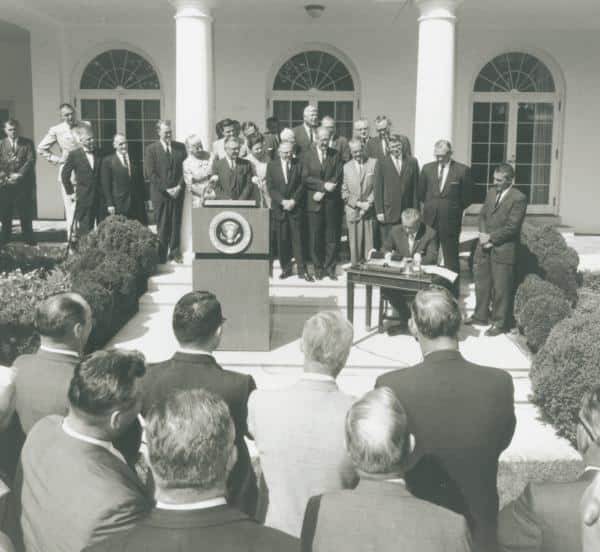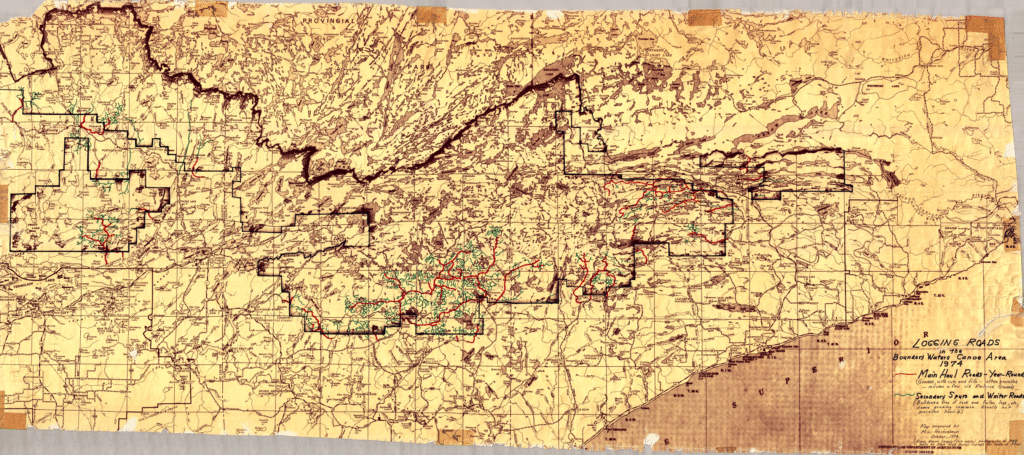September 3 marks the anniversary of The Wilderness Act of 1964, a landmark piece of legislation in American conservation history, which established a national policy to protect wilderness areas for future generations. The act provided protections for the Boundary Waters Canoe Area, a pristine expanse of lakes, forests, and waterways in northeastern Minnesota – which is not only the largest wilderness area east of the Rockies, but also the most widely used.
“A wilderness, in contrast with those areas where man and his own works dominate the landscape, is hereby recognized as an area where the earth and its community of life are untrammeled by man, where man himself is a visitor who does not remain.” 78 Stat. 890 – Wilderness Act
The Wilderness Act: a brief history

Prior to the Wilderness Act, there was growing concern among conservationists and environmentalists about the rapid development and exploitation of America’s natural resources. Recognizing the need to protect certain areas from human interference, Congress passed the Wilderness Act in 1964, following decades of advocacy by conservation groups. The act defined wilderness as “an area where the earth and its community of life are untrammeled by man, where man himself is a visitor and does not remain.”
Minnesota Senator Hubert Humphrey was instrumental passing the Act, and incorporating the BWCA into the newly established National Wilderness System. He and others in congress recognized the importance of protecting the wilderness character of this unique canoe country.
President Lyndon Johnson signed the act into law an act on September 3, 1964 and remarked, “In this century, Americans have wisely and have courageously kept a faithful trust to the conservation of our natural resources and beauty.”
The creation of the BWCAW
In the early 20th century, the region was recognized for its exceptional natural beauty and recreational potential. However, threats such as logging, mining, and hydroelectric development posed significant risks to its pristine state.
While the 1964 Act prohibited the use of motorboats and snowmobiles within wilderness areas, it allowed exceptions for areas where use of motors was well established within the BWCA, which was in conflict with the definition of wilderness protection. The Boundary Waters Wilderness Act of 1978 Resolving remaining conflicts took decades of advocacy, the tireless work of conservationists, including and the support of local communities, the Boundary Waters was designated a wilderness area in 1978.
The BWCAW is a living testament to the vision and dedication of those who fought for wilderness protection, which included the passionate leadership of many Minnesotans, including Ernest Oberholtzer, Sigurd Olson, Sewell Tyng, Frank Hubachek, Charles Kelly and Frederick Winston. This designation ensured that the region would be protected from future development and would remain a place where visitors could experience the solitude and tranquility of nature.

The Wilderness Act’s impact on the BWCAW
The Wilderness Act has been instrumental in preserving the BWCAW’s unique character. By prohibiting motorized vehicles, roads, and permanent structures, the act has maintained the area’s pristine wilderness quality. This has allowed for the flourishing of diverse ecosystems and provided opportunities for visitors to enjoy a truly immersive outdoor experience.
Moreover, the Wilderness Act helped to protect the BWCAW from the negative impacts of commercialization and tourism. By limiting development and emphasizing low-impact recreation, the act has ensured that the area remains a place of solitude and reflection.
The Act’s impact extends far beyond the BWCAW. The National Wilderness Preservation System, created by the Act, now covers nearly 112 million acres of land across the United States. The Forest Service manages more than half of this land, ensuring that these pristine areas are protected for future generations. USDA Forest Service Chief Randy Moore states, “…these wild and wonderful wilderness areas need protection and thoughtful management, especially in our ever-changing modern world, so they can be sustained for generations to come.”
What’s next for the Boundary Waters wilderness
Despite its protected status, the BWCAW faces ongoing challenges. The threat of mining pollution, climate change, and increased visitation pressure have raised concerns about its future. To address these threats, conservationists and policymakers are working to strengthen protections for the BWCAW and ensure its long-term sustainability.
Provisions established by The Wilderness Act were essential in preserving the BWCAW’s natural beauty, recreational opportunities, and ecological integrity. As the world continues to face environmental challenges, the BWCAW serves as a powerful reminder of the importance of protecting wilderness areas for future generations. Groups like Friends of the Boundary Waters, Save the Boundary Waters, WaterLegacy, MCEA, Sierra Club, the Wilderness Society, the Quetico Superior Foundation and others continue to advocate for wilderness protection.
This year, the White House proclaimed September as National Wilderness Month which will serve as an annual reminder of the importance of our wilderness areas.
More information:
- USDA Forest Service: Celebrating 60 years of the Wilderness Act
- Celebrating 60 years of the Wilderness Act and envisioning the next 60 years of wilderness protection

